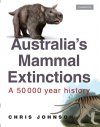![Australia's Mammal Extinctions Australia's Mammal Extinctions]()
Click to have a closer look
About this book
Contents
Customer reviews
Biography
Related titles
About this book
Of the forty mammal species known to have vanished in the world in the last 200 years, almost half have been Australian. The continent has the worst record of mammal extinctions, with over 65 mammal species having vanished in the last 50 000 years. It began with the great wave of megafauna extinctions in the last ice-age, and continues today, with many mammal species vulnerable to extinction. The question of why mammals became extinct, and why so many became extinct in Australia has been debated by experts for over a century and a half and we are no closer to agreement on the causes. This book introduces readers to the great mammal extinction debate. Chris Johnson takes us on a detective-like tour of these extinctions, uncovering how, why and when they occurred.
'This book makes a very well argued case for patterns and causes of mammal extinctions in Australia from the late Pleistocene into the period of European occupation. It gives an impressive range of evidence - palaeontological, palaeoenvironmental, archaeological, historical, ecological - to make the case. I thoroughly recommend it.' Bruno David, Monash University
Contents
Preface and Acknowledgments; Glossary; 1. Introduction - a brief history of Australian mammals; Part I. Mammals and People in Ice-Age Australia - 2.6 Million to 10,000 Years Ago: 2. The Pleistocene Megafauna; 3. What caused the Megafauna extinctions? 150 years of debate; 4. Two dating problems - human arrival and Megafauna extinction; 5. The changing environment of Late Pleistocene Australia; 6. Testing hypotheses on Megafauna extinction; 7. The aftermath: ecology consequences of Megafauna extinction; Part II. The Late Pre-Historic Period - 10,000 to 200 Years Ago; 8. Environmental change and human history in aboriginal Australia; 9. Dingoes, people, and other mammals in Holocene Australia; Part III. Europeans and Their New Mammals - The Last 200 Years; 10. Mammal extinction in European Australia; 11. What caused the recent extinctions?; 12 Interaction: rabbits, sheep and dingoes; 13. Conclusions - the history in review.
Customer Reviews
Biography
Dr Chris Johnson is a Reader in the School of Tropical Biology at James Cook University




































